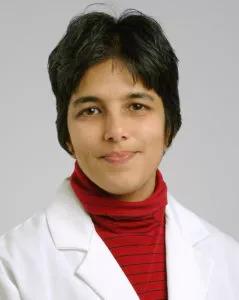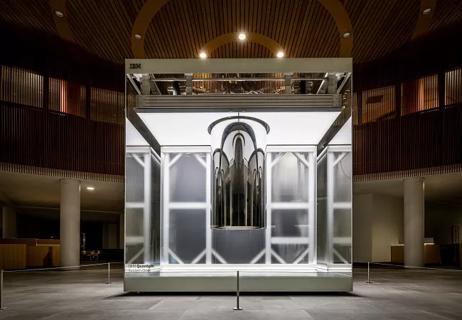Dr. Anand-Apte named Chair for Ophthalmology Research

It was actually her lab research in cancer that inspired her passion for eyes and vision.
Advertisement
Cleveland Clinic is a non-profit academic medical center. Advertising on our site helps support our mission. We do not endorse non-Cleveland Clinic products or services. Policy
Cleveland Clinic’s Bela Anand-Apte, MBBS, PhD, MBA, was studying tumor angiogenesis when she became interested in tissue inhibitor of metalloproteinases-3 (TIMP3), a protein whose physiological function is to inhibit pathological growth of new blood vessels. The protein that kept blood vessels in check also was linked to eye disease, specifically Sorsby fundus dystrophy and age-related macular degeneration (AMD), the leading cause of vision loss in people over age 60. A mutation in the TIMP3 gene caused Sorsby fundus dystrophy, an inherited macular degenerative disease in which patients lose vision because of abnormal growth and leakage of blood vessels in the back of the eye.
That realization was a turning point for Dr. Anand-Apte.

Bela Anand-Apte, MBBS, PhD, MBA
“I started reading more about vision and the eye and was totally engrossed,” she says. “The eye is an absolutely beautifully designed organ.”
Her reverence for the anatomy is equal to her respect for its function.
“The way vision works is fascinating, and the loss of vision can be devastating,” she says. “Vision loss will not end your life, but it can change it drastically. That is why we do research: to make an impact on people’s lives. Clinics are full of patients with vision loss. With every scientific finding, we are a step closer to preventing or curing it.”
In addition to Dr. Anand-Apte’s study of abnormal blood vessel growth and leakage in eye disease, she recently took on a new assignment: the Llura and Gordon Gund Endowed Chair for Ophthalmology Research at Cleveland Clinic. In this Q&A, Dr. Anand-Apte explains more about her department’s focus and basic science’s impact on the future of eye care.
Advertisement
Dr. Anand-Apte: It is a different mindset. Together with Cole Eye Institute Chair Daniel F. Martin, MD, I am responsible for shaping the growth of ophthalmic research at Cleveland Clinic. Our strategic growth initiative will build on our strengths and fill in research areas that will be critical in the near future.
Instead of just running my own lab and focusing on my own research, I am now responsible for all 80-plus people in our department, including more than a dozen principal investigators, each with their own lab. My goal is to make sure they have the tools and infrastructure to make progress and fulfill our mission to do good research, move science forward and train the next generation of scientists. Part of that involves securing and distributing grant money, ensuring investigators have all the resources they need to be successful.
For example, in the past year our department received a $100,000 grant from the Cleveland Eye Bank Foundation, which we will use to begin work on new, innovative ideas before applying for larger grants. Some of these funds are currently being used for a bioinformatics study on amblyopia, helping one of our research teams collect preliminary data on the utility of artificial intelligence. We also have an unrestricted grant from Research to Prevent Blindness as well as P30 funding from the National Eye Institute (NEI) that allows for core services for our investigators. A National Institutes of Health (NIH) T32 training grant funds graduate students, medical students and postdoctoral fellows engaged in eye research. Additionally, we have received significant resources from our philanthropic supporters to move our research forward.
Advertisement
Dr. Anand-Apte: Our department is committed to improving the understanding of the molecular and cellular basis of vision loss and using that knowledge to develop therapeutics. Currently we have teams investigating macular degeneration (both juvenile and age-related), diabetic retinopathy, retinopathy of prematurity, retinitis pigmentosa, ciliopathies, uveal melanoma and corneal disorders.
Cole Eye Institute is uniquely designed to house both clinicians and basic science investigators under one roof. This close collaboration provides a huge value, not to mention enables the involvement of patients in our work.
In order to further our impact, I expect that we will increase the number of both lab researchers and physician investigators. Because Cole Eye Institute is already known for its work in retinal disease, my goal is to build on our strengths and expand research teams investigating macular degeneration, diabetic retinopathy and inherited degenerations (pediatric retinal disease). In addition, we will build our research program in glaucoma and corneal disorders.
I also plan to develop our use of bioinformatics. Cole Eye Institute has a huge patient population with lots of data that could be invaluable across our retina, glaucoma and cornea research teams. Efforts in gene and cell therapy will be a big push as well.
We also have a very grateful patient population that has generously supported our innovative work through philanthropic gifts. We understand the importance of philanthropy and how it can help move a bold idea into a research protocol that can gain ongoing support from entities such as the NEI/NIH.
Advertisement
Dr. Anand-Apte: Ophthalmology is blazing a trail with gene therapy. It is one of the few areas of medicine where gene therapy has worked so far. Cell therapy is not far behind.
I think the future of ophthalmic research will center on gene therapy. The eye is unique because you can deliver gene therapy straight to the eye, straight into the cells you are targeting. With other diseases, you need to deliver gene therapy systemically, which can cause adverse effects. Systemic effects are usually not a major concern when treating eye disease.
Progress toward elimination of vision loss will be made when we invite collaboration between basic scientists, clinicians and patients. It takes those three groups working together. Research isn’t just “bench to bedside.” It really is clinic to bench and then back to clinic. Without patient involvement — which helps us understand disease and its issues — researchers cannot begin to unravel how to diagnose and treat disease. It is important that patients realize they are part of the research process and that researchers realize the incredible value patients bring.
That collaborative, patients-first model is already in practice at Cleveland Clinic. As the ophthalmology field at large incorporates that model, research can move faster. The COVID-19 pandemic has taught us that when there is an urgent need, we can do things at an incredibly fast pace. COVID vaccines were developed in one year while previous vaccines took 15 years or longer. If we have that same urgency for vision disorders, who knows what we can achieve?
Advertisement
Advertisement

First full characterization of kidney microbiome unlocks potential to prevent kidney stones

Researchers identify potential path to retaining chemo sensitivity

Large-scale joint study links elevated TMAO blood levels and chronic kidney disease risk over time

Investigators are developing a deep learning model to predict health outcomes in ICUs.

Preclinical work promises large-scale data with minimal bias to inform development of clinical tests

Cleveland Clinic researchers pursue answers on basic science and clinical fronts

Study suggests sex-specific pathways show potential for sex-specific therapeutic approaches

Cleveland Clinic launches Quantum Innovation Catalyzer Program to help start-up companies access advanced research technology